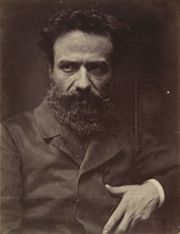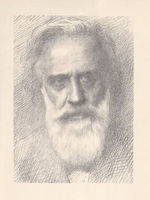
Alphonse Legros
Encyclopedia

Painting
Painting is the practice of applying paint, pigment, color or other medium to a surface . The application of the medium is commonly applied to the base with a brush but other objects can be used. In art, the term painting describes both the act and the result of the action. However, painting is...
, etcher and sculptor was born in Dijon
Dijon
Dijon is a city in eastern France, the capital of the Côte-d'Or département and of the Burgundy region.Dijon is the historical capital of the region of Burgundy. Population : 151,576 within the city limits; 250,516 for the greater Dijon area....
. His father was an accountant, and came from the neighbouring village of Véronnes
Véronnes
Véronnes is a commune in the Côte-d'Or department in eastern France.-Population:-References:*...
.
Young Legros frequently visited the farms of his relatives, and the peasants and landscapes of that part of France are the subjects of many of his pictures and etchings. He was sent to the art school at Dijon with a view to qualifying for a trade, and was apprenticed to Maître Nicolardo, house decorator and painter of images. In 1851 Legros left for Paris to take another situation; but passing through Lyon
Lyon
Lyon , is a city in east-central France in the Rhône-Alpes region, situated between Paris and Marseille. Lyon is located at from Paris, from Marseille, from Geneva, from Turin, and from Barcelona. The residents of the city are called Lyonnais....
he worked for six months as journeyman wall-painter under the decorator Beuchot, who was painting the chapel of Cardinal Bonald in the cathedral.
In Paris he studied with Cambon, scene-painter and decorator of theatres, an experience which developed a breadth of touch such as Stallfield and Cox picked up in similar circumstances. At this time he attended the drawing-school of Lecoq de Boisbaudran (the "Petite école") where he found himself in sympathy with Jules Dalou
Jules Dalou
Aimé-Jules Dalou was a French sculptor, recognized as one of the most brilliant virtuosos of nineteenth-century France, admired for his perceptiveness, execution, and unpretentious realism.-Life:...
and Auguste Rodin
Auguste Rodin
François-Auguste-René Rodin , known as Auguste Rodin , was a French sculptor. Although Rodin is generally considered the progenitor of modern sculpture, he did not set out to rebel against the past...
. In 1855 Legros attended the evening classes of the École des Beaux Arts, and perhaps gained there his love of drawing from the antique, some of the results of which may be seen in the Print Room of the British Museum
British Museum
The British Museum is a museum of human history and culture in London. Its collections, which number more than seven million objects, are amongst the largest and most comprehensive in the world and originate from all continents, illustrating and documenting the story of human culture from its...
.

Paris Salon
The Salon , or rarely Paris Salon , beginning in 1725 was the official art exhibition of the Académie des Beaux-Arts in Paris, France. Between 1748–1890 it was the greatest annual or biannual art event in the Western world...
of 1857: one was rejected, and formed part of the exhibition of protest organized by Bonvin in his studio; the other, which was accepted, was a profile portrait of his father. This work was presented to the museum at Tours by the artist when his friend Cazin
Jean Charles Cazin
Jean Charles Cazin , French landscape painter and ceramicist, son of a well-known doctor, FJ Cazin , was born at Samer, Pas-de-Calais....
was curator. Champfleury saw the work in the Salon, and sought out the artist to enlist him in the small army of so-called "Realists," comprising (round the noisy glory of Courbet
Gustave Courbet
Jean Désiré Gustave Courbet was a French painter who led the Realist movement in 19th-century French painting. The Realist movement bridged the Romantic movement , with the Barbizon School and the Impressionists...
) all those who raised protest against the academical trifles of the degenerate Romantics
Romanticism
Romanticism was an artistic, literary and intellectual movement that originated in the second half of the 18th century in Europe, and gained strength in reaction to the Industrial Revolution...
.
In 1859 Legros's Angelus was exhibited, the first of those quiet church interiors, with kneeling figures of patient women, by which he is best known as a painter. Ex Voto (1861), a work of great power and insight, now in the museum at Dijon, was received by his friends with enthusiasm, but it only obtained a mention at the Salon. Legros came to England in 1863 and in 1864 married Miss Frances Rosetta Hodgson. At first he lived by his etching and teaching. He then became teacher of etching at the South Kensington School of Art, and in 1876 Slade Professor at University College, London.
.jpg)
.jpg)
Italy
Italy , officially the Italian Republic languages]] under the European Charter for Regional or Minority Languages. In each of these, Italy's official name is as follows:;;;;;;;;), is a unitary parliamentary republic in South-Central Europe. To the north it borders France, Switzerland, Austria and...
a very important part of artistic training, and in order that his students should have the benefit of such study he devoted a part of his salary to augment the income available for a travelling studentship. His later works, after he resigned his professorship in 1892, were more in the free and ardent manner of his early days—imaginative landscapes, castles in Spain
Spain
Spain , officially the Kingdom of Spain languages]] under the European Charter for Regional or Minority Languages. In each of these, Spain's official name is as follows:;;;;;;), is a country and member state of the European Union located in southwestern Europe on the Iberian Peninsula...
, and farms in Burgundy, etchings like the series of "The Triumph of Death," and the sculptured fountains for the gardens of the duke of Portland at Welbeck.
He died in Watford
Watford
Watford is a town and borough in Hertfordshire, England, situated northwest of central London and within the bounds of the M25 motorway. The borough is separated from Greater London to the south by the urbanised parish of Watford Rural in the Three Rivers District.Watford was created as an urban...
, Hertfordshire
Hertfordshire
Hertfordshire is a ceremonial and non-metropolitan county in the East region of England. The county town is Hertford.The county is one of the Home Counties and lies inland, bordered by Greater London , Buckinghamshire , Bedfordshire , Cambridgeshire and...
, England.
Works
Pictures, drawings and etchings by Legros, besides those already mentioned, may be seen in the following galleries and museums:
- "Amende Honorable," "Dead Christ," bronzes, medals and twenty-two drawings, in the Luxembourg, Paris
- "Landscape," "Study of a Head," and portraits of Browning, Burne-Jones, Cassel, Huxley and Marshall, at the Victoria and Albert MuseumVictoria and Albert MuseumThe Victoria and Albert Museum , set in the Brompton district of The Royal Borough of Kensington and Chelsea, London, England, is the world's largest museum of decorative arts and design, housing a permanent collection of over 4.5 million objects...
, Kensington - "Femmes en prière," National Gallery of British Art
- "The Tinker," and six other works from the lonides Collection, bequeathed to South Kensington
- "Christening," "Barricade," "The Poor at Meat," two portraits and several drawings and etchings, collection of Lord Carlisle
- "Two Priests at the Organ," "Landscape" and etchings, collection of Rev. Stopford Brooke
- "Head of a Priest," collection of Mr Vereker Hamilton
- "The Weed-burner," some sculpture and a large collection of etchings and drawings, Mr Guy Knowles
- "Psyche," collection of Mr LW Hudson
- "Snow Scene," collection of George Frederic WattsGeorge Frederic WattsGeorge Frederic Watts, OM was a popular English Victorian painter and sculptor associated with the Symbolist movement. Watts became famous in his lifetime for his allegorical works, such as Hope and Love and Life...
, R.A. - thirty-five drawings and etchings, the Print Room, British Museum
- "Jacob's Dream" and twelve drawings of the antique, Cambridge
- "Saint Jerome," two studies of heads and some drawings, Manchester
- "The Pilgrimage" and "Study made before the Class," Liverpool Walker Art Gallery
- "Study of Heads," Peel Pan Museum, Salford.
See Dr Hans W Singer, "Alphonse Legros," Die graphischen Künste (1898); Léonce Bénédite, "Alphonse Legros," Revue d'an (Paris, 1900); Cosmo Monkhouse
William Cosmo Monkhouse
William Cosmo Monkhouse , English poet and critic.-Biography:Monkhouse was born in London. His father, Cyril John Monkhouse, was a solicitor; his mother's maiden name was Delafosse...
, "Professor Legros," Magazine of Art (1882).

